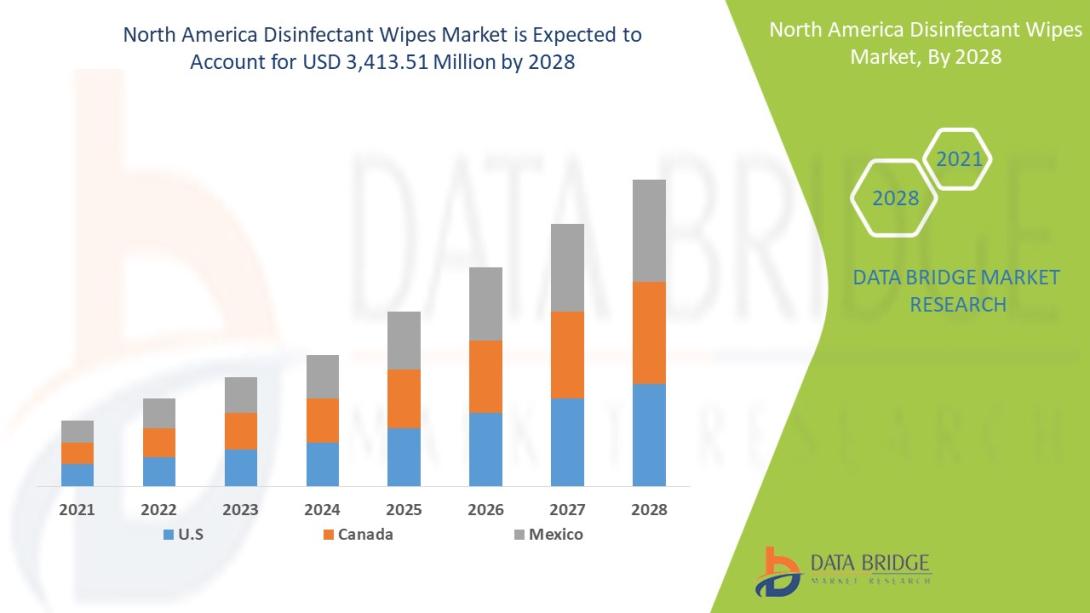
In a world increasingly conscious of hygiene and sanitation, North America disinfectant wipes market have evolved from a household convenience to a critical component of public health. Nowhere is this more evident than in North America, where the market for disinfectant wipes has experienced substantial growth in recent years—driven by pandemic-related awareness, healthcare-associated infection (HAI) prevention efforts, and consumer preference for convenience.
From hospitals and schools to households and commercial offices, disinfectant wipes offer an easy, quick, and effective way to clean surfaces, kill pathogens, and maintain a sanitary environment. This surge in demand is shaping a thriving market with innovation, regulatory changes, and competition on the rise.
Get More Details: https://www.databridgemarketresearch.com/reports/north-america-disinfectant-wipes-market
Market Overview
The North America disinfectant wipes market was valued at USD 1.7 billion in 2023 and is projected to surpass USD 2.5 billion by 2030, growing at a CAGR of 5.6% during the forecast period. The United States dominates the regional market, accounting for over 85% of total revenue, while Canada is witnessing rapid adoption across healthcare and commercial sectors.
Market Segmentation
1. By Product Type
- Alcohol-Based Wipes – Highly effective in killing viruses and bacteria, popular in healthcare settings.
- Quaternary Ammonium Compound (Quats) Wipes – Preferred for non-alcohol environments like schools and daycare centers.
- Bleach-Based Wipes – Used in industrial and clinical sanitation.
- Natural/Bio-Based Wipes – Gaining popularity among eco-conscious consumers.
2. By Application
- Healthcare Facilities – Hospitals, clinics, and long-term care centers.
- Households – Kitchens, bathrooms, and electronics.
- Commercial & Institutional Use – Schools, offices, gyms, retail, and transportation hubs.
- Food Industry – Surfaces in restaurants, food trucks, and industrial kitchens.
3. By Distribution Channel
- Retail Stores (Supermarkets, Pharmacies)
- Online Channels (Amazon, Brand Websites)
- Wholesale/Direct Distribution to Institutions
Key Growth Drivers
🦠 Post-Pandemic Hygiene Awareness
COVID-19 drastically changed consumer behavior, making disinfectant wipes a household staple for preventing viral spread.
🏥 Hospital-Acquired Infection Prevention
Hospitals and clinics rely on EPA-approved disinfectant wipes to reduce the risk of HAIs, especially in ICUs and surgical units.
🌿 Demand for Eco-Friendly Solutions
Consumers are increasingly choosing biodegradable wipes and refillable containers, promoting sustainability in surface cleaning.
📦 E-Commerce Boom
Direct-to-consumer (DTC) models and subscription services are making disinfectant wipes easily accessible, especially in remote or underserved areas.
Challenges in the Market
⚠ Environmental Concerns
Most disinfectant wipes are non-biodegradable and contribute to landfill waste, raising concerns among regulators and environmental groups.
⚠ Ingredient Sensitivity & Safety
Harsh chemicals can cause skin irritation or respiratory issues, especially in sensitive populations, driving demand for gentler formulations.
⚠ Regulatory Compliance
Wipes must meet EPA and FDA standards, especially in healthcare and food preparation settings. Frequent regulatory updates require manufacturers to remain agile.
Competitive Landscape
Key players are investing in product diversification, antimicrobial research, and sustainability initiatives to remain competitive.
Top Companies:
- Clorox Company – Market leader with a wide range of EPA-approved disinfecting wipes.
- Procter & Gamble (Lysol Brand) – Dominates household disinfectant wipe sales.
- Kimberly-Clark Corporation – Supplies disinfectant solutions for medical and industrial sectors.
- GOJO Industries (Purell) – Gaining traction with alcohol-based sanitizing wipes.
- Seventh Generation & Method – Pioneers in natural and plant-based disinfectant wipes.
Future Trends
🌱 Sustainable Packaging & Materials
Expect growth in compostable wipes, reusable canisters, and zero-waste refill pouches.
🔬 Antimicrobial Innovation
Emerging technologies will feature long-lasting microbial protection and broad-spectrum antiviral efficacy.
🧼 Multi-Surface & Dual-Purpose Wipes
Innovation in wipes that clean and disinfect a wide variety of surfaces (e.g., electronics, textiles, medical equipment).
🧠 Smart Wipe Dispensers
Touchless, sensor-based wipe dispensers for public spaces are being adopted in airports, malls, and hospitals.
Conclusion
The North America disinfectant wipes market is thriving in a landscape driven by health-conscious consumers, evolving sanitation standards, and technological advancements. As hygiene continues to be a public and personal priority, disinfectant wipes will remain a cornerstone of daily cleaning routines across all sectors. Companies that invest in sustainable innovation, safety, and regulatory compliance will lead the way in this essential and fast-evolving market.
FAQs
1. What are disinfectant wipes made of?
Disinfectant wipes are typically made of nonwoven fabrics soaked in chemical agents such as alcohol, quaternary ammonium compounds (quats), or bleach, designed to kill bacteria, viruses, and fungi.
2. Are disinfectant wipes safe to use on food-contact surfaces?
Only food-grade or EPA-certified wipes labeled for such use should be used on food-contact surfaces. Others may leave harmful residues.
3. What’s the difference between sanitizing and disinfecting wipes?
Sanitizing wipes reduce germs to safe levels, while disinfecting wipes kill nearly all bacteria and viruses on hard surfaces, offering a higher level of protection.
4. Are there eco-friendly disinfectant wipes?
Yes. Brands like Seventh Generation and CleanWell offer plant-based, biodegradable wipes with compostable packaging options.
5. Where can I buy disinfectant wipes in bulk?
Bulk purchases are available through wholesale suppliers, Amazon Business, institutional distributors, and direct from manufacturers’ websites.

